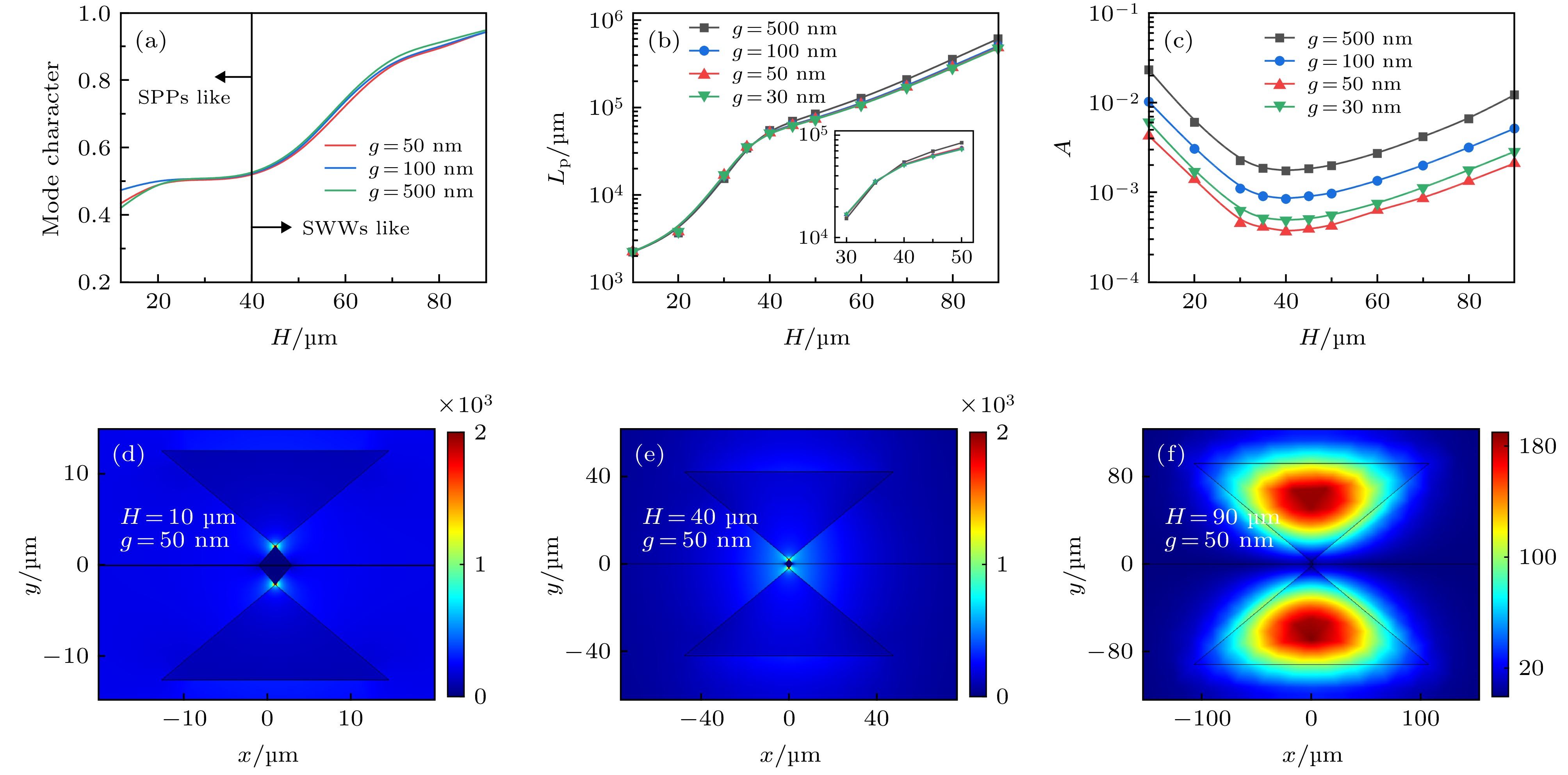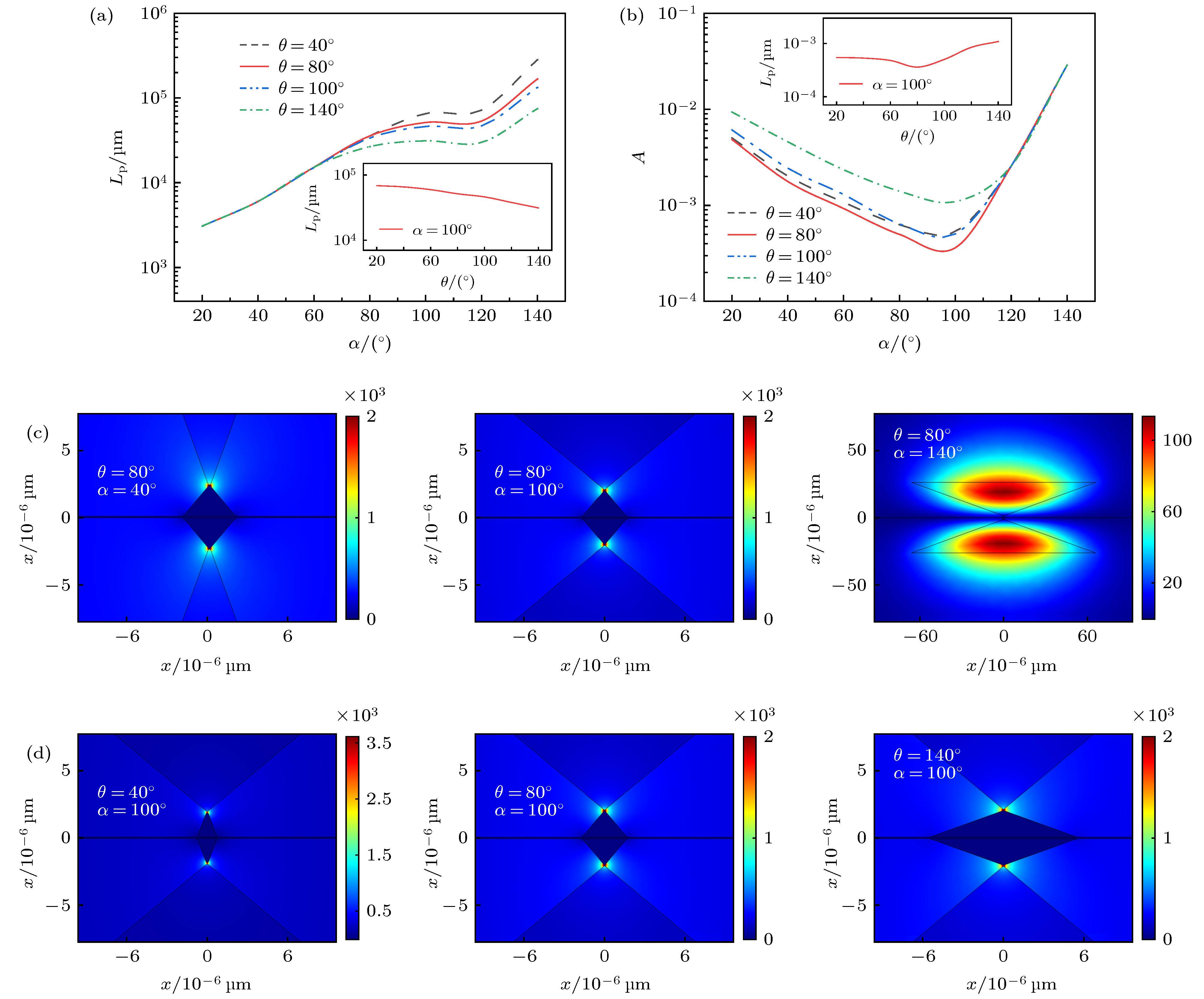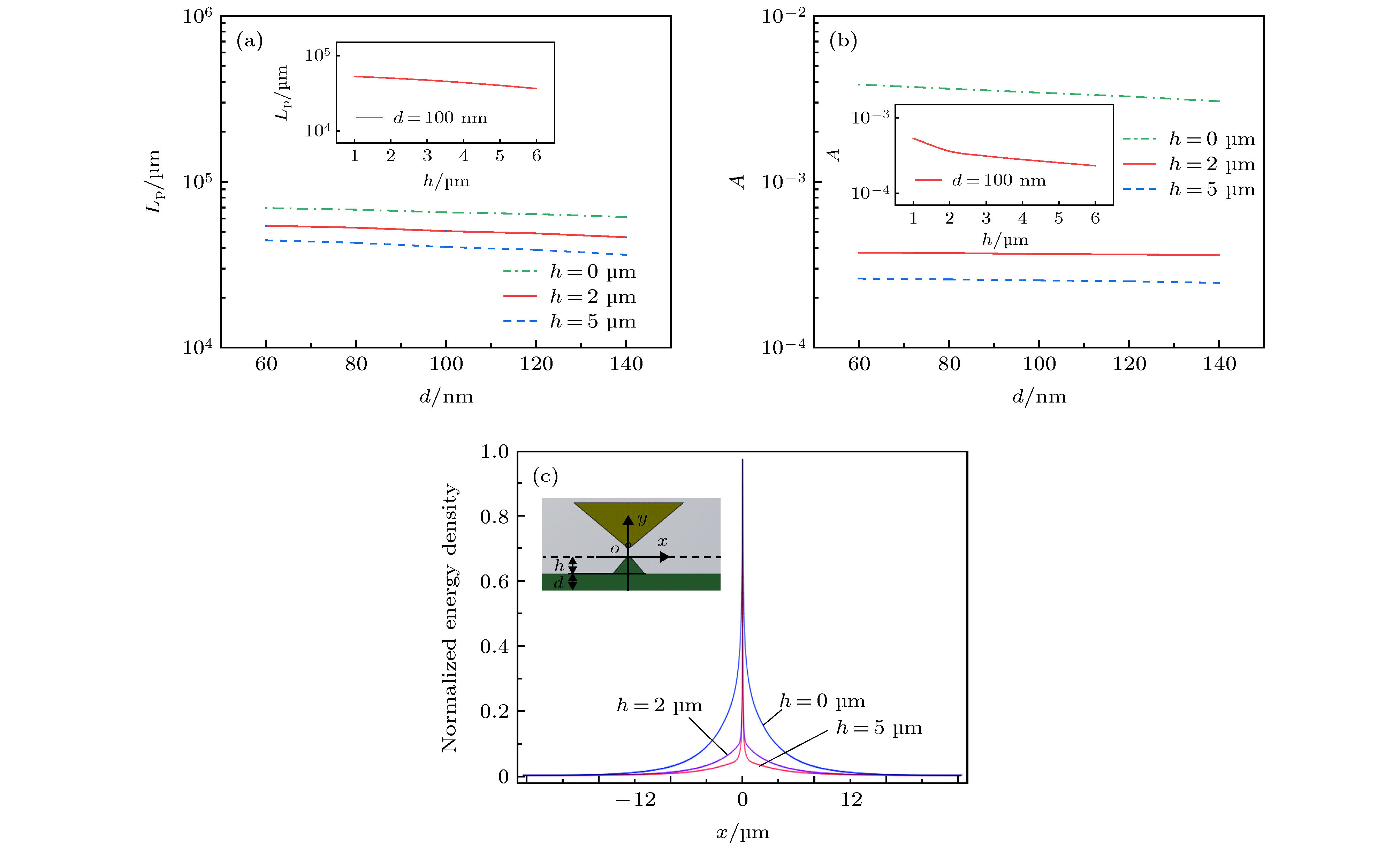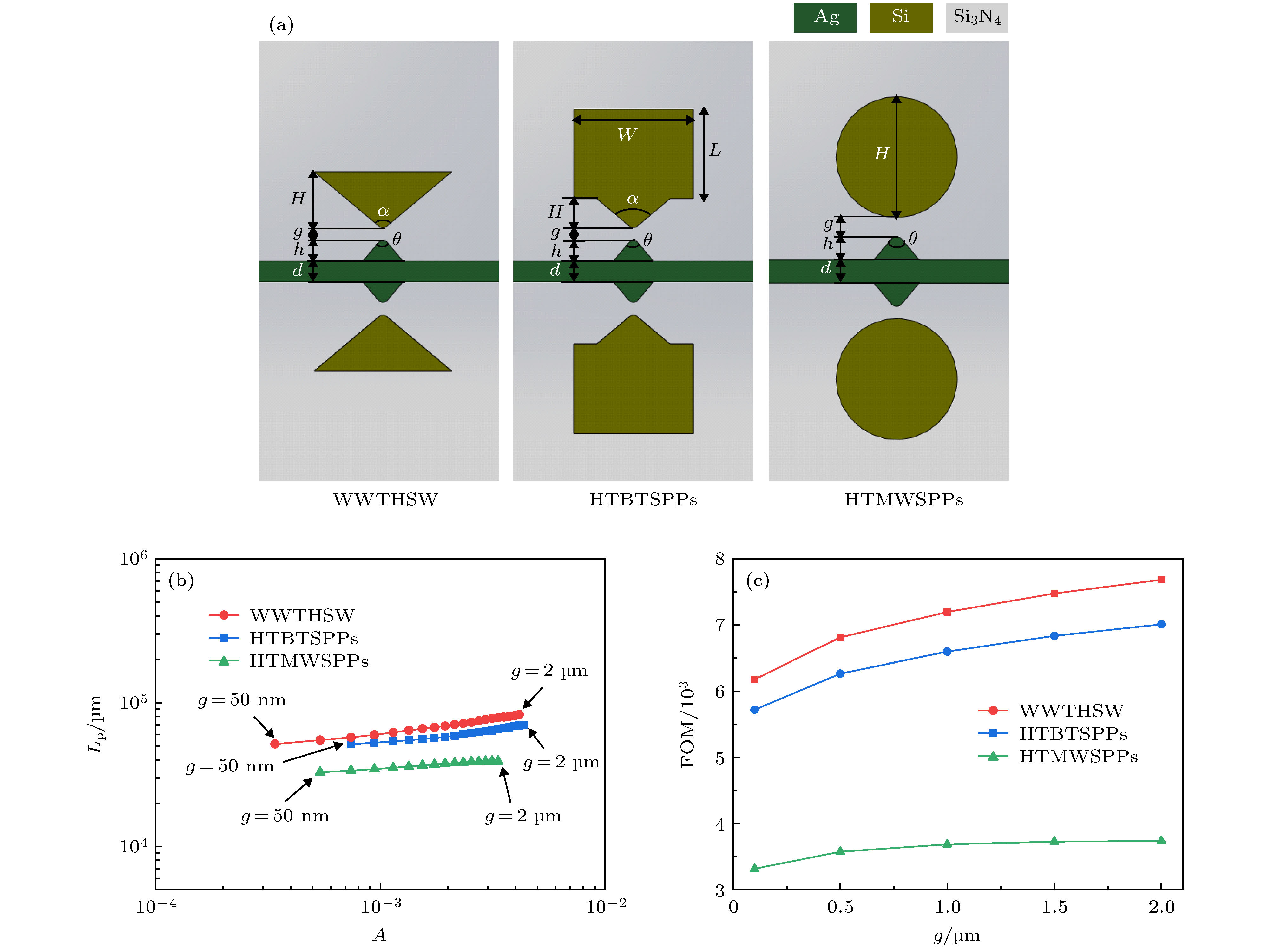-
本文研究了一种适用于太赫兹频段的对称双楔形混合等离子体波导. 采用有限元法对其混合模式特征进行数值模拟, 阐述了波导的传播长度、归一化有效模场面积和品质因子等特性随波导几何参数的变化规律. 结果表明, 对称双楔形混合等离子体波导在太赫兹频段可获得良好的模场约束能力和低损耗特性, 在有效模场面积达到λ2/10280时, 传播长度达到51 × 103 μm. 波导参数最优时的平行对称楔形波导在忽略波导间串扰时, 波导间距小于16 μm时的耦合长度约为8958 μm. 通过对比发现, 相比于先前的对称微楔形波导结构和对称蝴蝶结波导结构, 对称双楔形混合等离子体波导在传输特性和耦合特性方面都具有更大的优势, 将在光学力捕获、生物分子传输以及高密度集成电路设计等方面具有潜在的应用前景.A symmetrical wedge-to-wedge THz hybrid SPPs waveguide (WWTHSW) with low propagation loss is investigated. The WWTHSW consists of two identical dielectric wedge waveguides symmetrically placed on each side of a micro wedge-patterned thin metal film. The mode characteristics of the WWTHSW, such as the propagation length (Lp), the normalized effective mode area (A) and the figure of merit (FOM) are analyzed by using the finite element method (FEM). Firstly, the influences of the height of Si micro wedge waveguide (H) and the gap between two wedges (g) on Lp and A are studied. For the same g, A first decreases and then increases with the increase of H. A achieves a minimum at an H of ~40 μm. However, Lp monotonically increases as H increases. The change of Lp slows down when H is greater than 40 μm. At a fixed H, Lp slightly increases with the increase of g. But A achieves a minimum when g is ~50 nm. Secondly, the dependencies of the mode characteristics of the WWTHSW on Si wedge tip angle (α) and Ag wedge tip angle (θ) are analyzed. At a fixed α, θ has less effect on Lp and A. As α increases at a fixed θ, Lp increases monotonically but A decreases firstly and then increases. A reaches a minimum when α increases to ~100°. Then, the change of Lp and A with the thicknesses of Ag film (d) and Ag wedge (h) are demonstrated. At a fixed h, both Lp and A slightly decrease as d increases. For the same d, Lp and A decrease with the increase of h. A for h = 0 μm is distinctly larger than those for h = 2 μm and h = 5 μm. According to the above optimizations, the parameters of the WWTHSW are chosen as d = 100 nm, g = 50 nm, h = 2 μm, θ = 80°, α = 100°, H = 40 μm. Under the optimal parameters, Lp of ~51 mm is obtained when Am reaches ~λ2/10280. Compared with the previous hybrid THz plasmonic waveguide, Lp of the WWTHSW increases by 3 times, and A decreases by an order of magnitude. This result reveals that the WWTHSW enables low-loss propagation and ultra-deep-subwavelength mode confinement at THz frequencies. At last, the coupling property of the parallel WWTHSW is investigated. The coupling length of ~8958 μm is achieved without the crosstalk between two parallel waveguides. By comparison, the WWTHSW has more advantages in terms of transmission and coupling characteristics than the previous micro wedge waveguide structure and bow-tie waveguide structure. In summary, due to the excellent transmission and coupling characteristics, the WWTHSW has great potential in the fields of optical force in trapping, biomolecules transporting, and in high-density integrated circuits design.
-
Keywords:
- hybrid plasmonic waveguide /
- surface plasmonpolaritons /
- transmission characteristics /
- coupling characteristics
[1] Andersen J, Solodukhov V 1978 IEEE T. Antenn. Propag. 26 598
 Google Scholar
Google Scholar
[2] Oulton R F, Sorger V J, Genov D A, Pile D F P, Zhang X J 2008 Nature Photon. 2 496
 Google Scholar
Google Scholar
[3] Li Qing, Pan D, Wei H, Xu H X 2018 Nano Lett. 18 2009
 Google Scholar
Google Scholar
[4] Bozhevolnyi S I, Volkov V S, Devaux, E, Laluet, J Y, Ebbesen, T W 2006 Nature 440 508
 Google Scholar
Google Scholar
[5] Zhu Z H, Garcia-Ortiz C E, Han Z H, Radko I P, Bozhevolnyi S I 2013 Appl. Phys. Lett. 103 061108
[6] Hassan K, Leroy F, Colas-Des-Francs G, Weeber, J C 2014 Opt. Lett. 39 697
 Google Scholar
Google Scholar
[7] Papaioannou S, Giannoulis G, Vyrsokinos K, Leroy F, Zacharatos F, Markey L, Weeber C J, Dereux A, Bozhevolnyi S, Prinzen A, Apostolopoulos D, Avramopoulos H, Pleros N 2015 IEEE Photon. Technol. Lett. 27 963
 Google Scholar
Google Scholar
[8] Hui F, Berini P 2016 J. Lightwave Technol. 34 2631
 Google Scholar
Google Scholar
[9] 涂鑫, 陈震旻, 付红岩 2019 物理学报 68 104210
 Google Scholar
Google Scholar
Tu X, Chen Z M, Fu H Y 2019 Acta Phys. Sin. 68 104210
 Google Scholar
Google Scholar
[10] Wang Y L, Li S L, Yan J Y, Li C, Jiang P, Wang L L, Yu L 2019 Nanophotonics 8 1271
 Google Scholar
Google Scholar
[11] Wang Y L, Li C, Duan G Y, Wang L L, Yu L 2019 Adv. Opt. Mater. 7 1801362
 Google Scholar
Google Scholar
[12] Mai W, Wang Y, Zhang Y, Cui L, Yu L 2017 Chin. Phys. Lett. 34 024204
 Google Scholar
Google Scholar
[13] Gosciniak J, Volkov V S, Bozhevolnyi S I, Markey L, Massenot S, Dereux A 2010 Opt. Express 18 5314
 Google Scholar
Google Scholar
[14] Berini P 2009 Adv. Opt. Photonic 1 484
 Google Scholar
Google Scholar
[15] Ma Y Q, Gerald F, Yuliya S, Wu Q 2014 Opt. Lett. 39 973
 Google Scholar
Google Scholar
[16] Pan M Y, Lin E H, Wang L, Wei P K 2014 Appl. Phys. A. 115 592
[17] Ma Y Q, Farrell G, Semenova Y, Wu Q 2015 J. Lightwave Technol. 33 3827
 Google Scholar
Google Scholar
[18] 贾智鑫, 段欣, 吕婷婷, 郭亚楠, 薛文瑞 2011 物理学报 60 057301
 Google Scholar
Google Scholar
Jia Z X, Du X, Lü T T, Guo Y N, Xue W R 2011 Acta Phys. Sin. 60 057301
 Google Scholar
Google Scholar
[19] Gong Q, Bian Y 2014 J. Lightwave Technol. 32 4504
 Google Scholar
Google Scholar
[20] Jacek G, Volkov V S, Bozhevolnyi S I, Markey L, Massenot S, Dereux A 2010 Optics Express 18 5314
[21] 彭滟, 施辰君, 朱亦鸣, 庄松林 2019 中国激光 46 0614002
 Google Scholar
Google Scholar
Peng Y, Shi C J, Zhu Y M, Zhuang S L 2019 Chin. J. Las. 46 0614002
 Google Scholar
Google Scholar
[22] 陈华, 汪力 2009 物理学报 58 4605
 Google Scholar
Google Scholar
Chen H, Wang L 2009 Acta Phys. Sin. 58 4605
 Google Scholar
Google Scholar
[23] Eldlio M, Ma Y Q, Maeda H, Cada M 2017 Infrared Phys. Technol. 80 93
 Google Scholar
Google Scholar
[24] Cao W, Song C Y, Lanier T E, Singh R, O’Hara J F, Dennis W M, Zhao Y P, Zhang W L 2013 Sci. Rep. 3 1766
 Google Scholar
Google Scholar
[25] Fitch M J, Osiander R 2004 J. Hopkins Apl. Technol. D. 25 348
[26] Berini P 2006 Opt. Express 14 13030
 Google Scholar
Google Scholar
[27] Moreno E, Rodrigo S G, Bozhevolnyi S I, Martín-Moreno L, García-Vidal F J 2008 Phys. Rev. Lett. 100 023901
 Google Scholar
Google Scholar
[28] Ma Y Q, Farrell G, Semenova Y, Chan H P, Zhang H Z, Wu Q 2013 Plasmonics 8 1259
 Google Scholar
Google Scholar
[29] Georgios V, Shanhui F 2008 Opt. Express 16 2129
 Google Scholar
Google Scholar
-
图 2 不同H和g时, WWTHSW的模式分析 (a) MC, (b) Lp, (c) A; 模场分布: (d) [H, g] = [10, 0.05] μm, (e) [H, g] = [40, 0.05] μm, (f) [H, g] = [90, 0.05] μm
Fig. 2. Modes analysis of the WWTHSW with different H and g: (a) MC, (b) Lp, and (c) A;and normalized EM energy density distributions: (d) [H, g] = [10, 0.05] μm; (e) [H, g] = [40, 0.05] μm; (f) [H, g] = [90, 0.05] μm.
-
[1] Andersen J, Solodukhov V 1978 IEEE T. Antenn. Propag. 26 598
 Google Scholar
Google Scholar
[2] Oulton R F, Sorger V J, Genov D A, Pile D F P, Zhang X J 2008 Nature Photon. 2 496
 Google Scholar
Google Scholar
[3] Li Qing, Pan D, Wei H, Xu H X 2018 Nano Lett. 18 2009
 Google Scholar
Google Scholar
[4] Bozhevolnyi S I, Volkov V S, Devaux, E, Laluet, J Y, Ebbesen, T W 2006 Nature 440 508
 Google Scholar
Google Scholar
[5] Zhu Z H, Garcia-Ortiz C E, Han Z H, Radko I P, Bozhevolnyi S I 2013 Appl. Phys. Lett. 103 061108
[6] Hassan K, Leroy F, Colas-Des-Francs G, Weeber, J C 2014 Opt. Lett. 39 697
 Google Scholar
Google Scholar
[7] Papaioannou S, Giannoulis G, Vyrsokinos K, Leroy F, Zacharatos F, Markey L, Weeber C J, Dereux A, Bozhevolnyi S, Prinzen A, Apostolopoulos D, Avramopoulos H, Pleros N 2015 IEEE Photon. Technol. Lett. 27 963
 Google Scholar
Google Scholar
[8] Hui F, Berini P 2016 J. Lightwave Technol. 34 2631
 Google Scholar
Google Scholar
[9] 涂鑫, 陈震旻, 付红岩 2019 物理学报 68 104210
 Google Scholar
Google Scholar
Tu X, Chen Z M, Fu H Y 2019 Acta Phys. Sin. 68 104210
 Google Scholar
Google Scholar
[10] Wang Y L, Li S L, Yan J Y, Li C, Jiang P, Wang L L, Yu L 2019 Nanophotonics 8 1271
 Google Scholar
Google Scholar
[11] Wang Y L, Li C, Duan G Y, Wang L L, Yu L 2019 Adv. Opt. Mater. 7 1801362
 Google Scholar
Google Scholar
[12] Mai W, Wang Y, Zhang Y, Cui L, Yu L 2017 Chin. Phys. Lett. 34 024204
 Google Scholar
Google Scholar
[13] Gosciniak J, Volkov V S, Bozhevolnyi S I, Markey L, Massenot S, Dereux A 2010 Opt. Express 18 5314
 Google Scholar
Google Scholar
[14] Berini P 2009 Adv. Opt. Photonic 1 484
 Google Scholar
Google Scholar
[15] Ma Y Q, Gerald F, Yuliya S, Wu Q 2014 Opt. Lett. 39 973
 Google Scholar
Google Scholar
[16] Pan M Y, Lin E H, Wang L, Wei P K 2014 Appl. Phys. A. 115 592
[17] Ma Y Q, Farrell G, Semenova Y, Wu Q 2015 J. Lightwave Technol. 33 3827
 Google Scholar
Google Scholar
[18] 贾智鑫, 段欣, 吕婷婷, 郭亚楠, 薛文瑞 2011 物理学报 60 057301
 Google Scholar
Google Scholar
Jia Z X, Du X, Lü T T, Guo Y N, Xue W R 2011 Acta Phys. Sin. 60 057301
 Google Scholar
Google Scholar
[19] Gong Q, Bian Y 2014 J. Lightwave Technol. 32 4504
 Google Scholar
Google Scholar
[20] Jacek G, Volkov V S, Bozhevolnyi S I, Markey L, Massenot S, Dereux A 2010 Optics Express 18 5314
[21] 彭滟, 施辰君, 朱亦鸣, 庄松林 2019 中国激光 46 0614002
 Google Scholar
Google Scholar
Peng Y, Shi C J, Zhu Y M, Zhuang S L 2019 Chin. J. Las. 46 0614002
 Google Scholar
Google Scholar
[22] 陈华, 汪力 2009 物理学报 58 4605
 Google Scholar
Google Scholar
Chen H, Wang L 2009 Acta Phys. Sin. 58 4605
 Google Scholar
Google Scholar
[23] Eldlio M, Ma Y Q, Maeda H, Cada M 2017 Infrared Phys. Technol. 80 93
 Google Scholar
Google Scholar
[24] Cao W, Song C Y, Lanier T E, Singh R, O’Hara J F, Dennis W M, Zhao Y P, Zhang W L 2013 Sci. Rep. 3 1766
 Google Scholar
Google Scholar
[25] Fitch M J, Osiander R 2004 J. Hopkins Apl. Technol. D. 25 348
[26] Berini P 2006 Opt. Express 14 13030
 Google Scholar
Google Scholar
[27] Moreno E, Rodrigo S G, Bozhevolnyi S I, Martín-Moreno L, García-Vidal F J 2008 Phys. Rev. Lett. 100 023901
 Google Scholar
Google Scholar
[28] Ma Y Q, Farrell G, Semenova Y, Chan H P, Zhang H Z, Wu Q 2013 Plasmonics 8 1259
 Google Scholar
Google Scholar
[29] Georgios V, Shanhui F 2008 Opt. Express 16 2129
 Google Scholar
Google Scholar
计量
- 文章访问数: 12239
- PDF下载量: 108
- 被引次数: 0














 下载:
下载:





